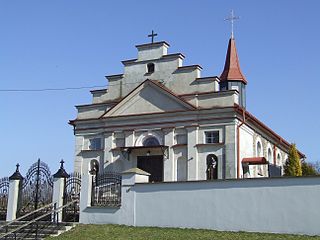Kossak is the surname of 4 generations of notable Polish painters, writers and poets, descending from the historical painter Juliusz Kossak. Notable people with this surname include:

Powązki Cemetery, also known as Stare Powązki, is a historic necropolis located in Wola district, in the western part of Warsaw, Poland. It is the most famous cemetery in the city and one of the oldest, having been established in 1790. It is the burial place of many illustrious individuals from Polish history. Some are interred along the "Avenue of the Distinguished" – Aleja Zasłużonych, created in 1925. It is estimated that over 1 million people are buried at Powązki.

Wojciech Horacy Kossak was a noted Polish painter and member of the celebrated Kossak family of artists and writers. He was the son of painter Juliusz Kossak, and twin brother of freedom fighter Tadeusz Kossak, and the father of two highly talented literary daughters, Maria Pawlikowska-Jasnorzewska and Magdalena Samozwaniec and of a painter son, Jerzy Kossak.

Juliusz Fortunat Kossak was a Polish historical painter and master illustrator who specialized in battle scenes, military portraits and horses. He was the progenitor of an artistic family that spanned four generations, father of painter Wojciech Kossak and grandfather of painter Jerzy Kossak.

Jerzy Maciej Kossak was a Polish realist painter specializing in military scenes. He was the son of painter Wojciech Kossak and grandson of painter Juliusz Kossak, a third-generation artist from a well-known and sought after family of painters, writers and poets.

Rakowicki Cemetery is a historic necropolis and a cultural heritage monument located on 26 Rakowicka Street in the centre of Kraków, Poland. It lies within the Administrative District No. 1 Stare Miasto meaning "Old Town" – distinct from the Kraków Old Town situated further south. Founded at the beginning of the 19th century when the region was part of Austrian Galicia, the cemetery was expanded several times, and at present covers an area of about 42 hectares. Many notable Cracovians, among them the parents of Pope John Paul II, are buried here.

Maria Pawlikowska-Jasnorzewska, née Kossak, was a prolific Polish poet known as the "Polish Sappho" and "queen of lyrical poetry" during Poland's interwar period. She was also a dramatist.
Żuławski is a Polish surname. Notable people with the surname include:

AST National Academy of Theatre Arts, is a drama school based in Kraków and Wrocław, Poland. It was founded in 1946 by actor Juliusz Osterwa, who took the initial steps leading to the establishment of the Academy through the amalgamation of three local studios; Stary Teatr, the Słowacki Theatre, and Iwo Gall's Dramatic Studio.

Poryte is a village in the administrative district of Gmina Stawiski, within Kolno County, Podlaskie Voivodeship, in north-eastern Poland. It lies approximately 6 kilometres (4 mi) west of Stawiski, 12 km (7 mi) south-east of Kolno, and 78 km (48 mi) west of the regional capital Białystok.

Tadeusz Kossak, was born into a noted Polish family of artists and writers. He was an officer in the Polish Army, a freedom fighter, and owner of a country estate in Górki Wielkie that became a hub for intellectuals of the era. He was the father of writer, activist, and World War II resistance fighter Zofia Kossak-Szczucka.
Gloria Kossak (1941–1991), Polish painter and poet, was a daughter of painter Jerzy Kossak and granddaughter of another renowned Polish painter, Wojciech Kossak, himself the son of Juliusz Kossak, the progenitor of the entire Kossak family of artists and writers, and precursor of a Polish school of battle-scene painting.

Powązki Military Cemetery is an old military cemetery located in the Żoliborz district, western part of Warsaw, Poland. The cemetery is often confused with the older Powązki Cemetery, known colloquially as "Old Powązki". The Old Powązki cemetery is located to the south-east of the military cemetery.
Anna Szatkowska was a World War II member of the Polish Home Army which she joined at the age of 16 to help in liberating Warsaw from German occupation. She served as first-aider. Sixty years later, she decided to describe her experience in a book, La Maison brulée.
Juliusz is a given name. Notable people with the name include:

Altenberg Publishing was a Polish publishing house active from 1880 until 1934; first, in the partitioned and later in sovereign Poland. It specialized in publishing high-quality book prints and illustrated albums.
Simona Gabriela Kossak was a biologist, ecologist, and professor of forest sciences. Kossak is known for her efforts to preserve the remnants of natural ecosystems in Poland. Her work dealt with, among other things, the behavioral ecology of mammals. She sometimes referred to herself as a "zoo-psychologist."